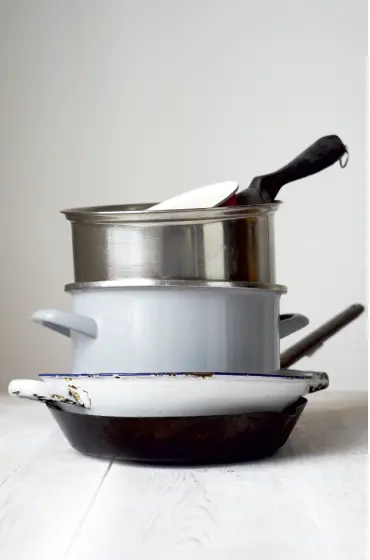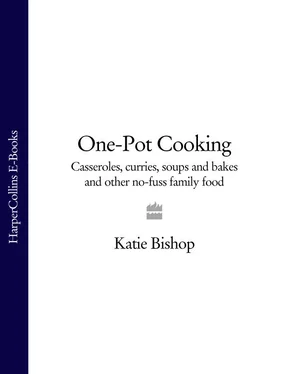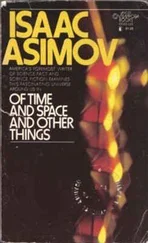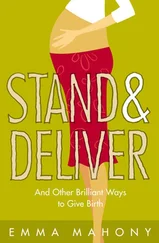ONE-POT COOKING
Casseroles, soups, curries, bakes and other no-fuss family food
Katie Bishop

Cover
Title Page ONE-POT COOKING Casseroles, soups, curries, bakes and other no-fuss family food Katie Bishop
Introduction
In a Pot
In a Pan
In a Wok
In a Bowl
In the Oven
Under the Grill
Index
Acknowledgements
About the Author
Copyright
About the Publisher

I have been writing about food for almost nine years now. A lot has changed in foodie fashion during that time, but one thing has remained constant, I always, without fail, get asked for ideas for simple, everyday, mid-week recipes. Recipes that are simple to make after a hard day and use everyday ingredients that are easily bought from the supermarket – or even the corner shop in some cases. Quick and easy dishes that don’t need hours of preparation or complicated techniques, and don’t create lots of mess. It was with this in mind that I decided to write a set of one-pot recipes.
I hope that the following pages will be different enough to be inspiring, but thoroughly do-able on an everyday basis. There are recipes for family food, some for entertaining, some for comforting, indulgent days, and others for frugal or healthy days. What they all have in common is that they are remarkably simple to make. It’s the kind of food that I cook day to day, so I know they fit around a busy lifestyle.
I have grouped the recipes by cooking method, rather than ingredient. I thought that this would be easier to adapt to your day – I don’t know about you, but sometimes I just don’t have time to preheat the oven, or the inclination to wash up a large crusty roasting tin. So on those days cooking in a pan or under the grill is usually in order. Some days I don’t even want to cook at all, which is where the ‘In a Bowl’ chapter comes into its own. For other days, when time is slightly less of an issue, there’s the oven or pot for longer, slower cooking.
Either way, I have taken ‘one pot’ as literally as possible. So all the recipes are cooked in one ‘utensil’, whether it is a casserole, pan, bowl, dish, grill pan or roasting tin. You will usually need a chopping board for each recipe, and if it benefits the recipe, I have on occasion allowed myself up to one small bowl for mixing or soaking ingredients before cooking. But my focus has most definitely been on minimising washing up and the use of equipment as much as possible. There are a couple of recipes that use two modes of cooking, where a dish is started on the hob and finished in the oven, for example, but I have purposefully kept this to a minimum to keep things as simple as possible.
Most importantly, however, I have written recipes that reflect the food that I, and my friends and family, like to eat – simple stove- or oven-to-table food that is nutritious, tasty and interesting. Most of the recipes are complete, balanced meals in themselves; others may just need a quick salad or some bread to go with it. I’ve also made use of the wide range of fresh noodles and cooked/microwave rice products available in supermarkets now, to make life easier. Why not! Alternatively, if you have leftover rice or noodles, these will be perfect to use in these recipes too – leftover rice needs to be cooled quickly (within an hour) and then covered and chilled immediately, for no more than 24 hours, before reheating thoroughly to limit germs forming. Never reheat rice more than once.
Each chapter has some puddings and sweet things included too, which shouldn’t really constitute meals in themselves – although I’m sure there are some who would be happy if this were the case! Of course, they’re all cooked or made in one pot too. The odd recipe uses raw egg white, so please be wary of this if cooking for the young, elderly or pregnant.
With simplicity comes some level of exposure. If you are making unfussy food with little faffing around, then the ingredients are very much on show. So I would always advocate using the best possible ingredients you can afford or find to maximise the results of each and every recipe. I realise that this is sometimes easier said than done and there are plenty of recipes in this book that use tins, packets or convenience products to save you time.
As with all my books, each and every recipe has been carefully tested and tweaked to make it as perfect as it can be. However, my food is ripe and ready for interpretation. So if you don’t like this or that; or you fancy a bit of this, but not that; then most of my recipes will take some customisation here and there – although I can’t guarantee the results if you go off spec! With the exception of the baking recipes, which in the main need to remain precise to make them work, feel free to make my recipes your own.
Either way I hope that you will enjoy every last mouthful, safe in the knowledge that there’s only one pot to wash up at the end of it all!
All the recipes in the book have been tested using metric measurements. I learnt to cook in pounds and ounces but the transition really is very easy, and I think metric measures produce more consistent, accurate results. There are conversions given throughout the book, but for consistency I would follow the metric measures every time.
All oven temperatures given are for conventional ovens. If you are using a fan oven, which tend to be rather more feisty heat wise, then I recommend dropping the temperature by about 15°C (½ Gas Mark) to achieve the same results. Check your manufacturer’s instructions for more detail.
Recipes using the oven or grill are written with the assumption that they will always be fully preheated unless otherwise stated.
All spoon measurements are assumed to be level, unless stated differently. A teaspoon equates to 5ml, and a tablespoon is 15ml.
You can assume that all eggs are medium sized, unless otherwise stated and free-range chicken and eggs are most definitely recommended. Happy chickens equal tasty eggs and meat.
All milk and other dairy products are full fat, unless otherwise stated. If you are vegetarian then you might want to swap conventional cheeses for vegetarian alternatives. There’s a great selection available from most major supermarkets.
Cooking with extra virgin olive oil is a waste of money! Over a certain temperature the flavour and aromas that you have paid a premium for will be lost. Always cook with simple olive oil or other oil as stated in the recipe and reserve extra virgin olive oil for uncooked dishes, sauces and dressings.
I always try to give accurate weights and measures for all ingredients, but sometimes a handful of this or that is in order. As a guide you could apply the following measurements for herbs which are the most likely victims of this willy-nilly approach:
Small handful = 5g (¼oz)
Medium handful = 10g (1/3oz)
Large handful = 20g (¾oz)
Some other helpful measurements:
1 lemon will produce 2 teaspoons of zest and 8 tablespoons (120ml/4½oz) of juice
1 lime will produce about 1 teaspoon of zest and about 2 tablespoons (30ml/1fl oz) of juice
1 orange will produce about 1 tablespoon of zest and about 10 tablespoons (150ml/5fl oz) of juice
Читать дальше














